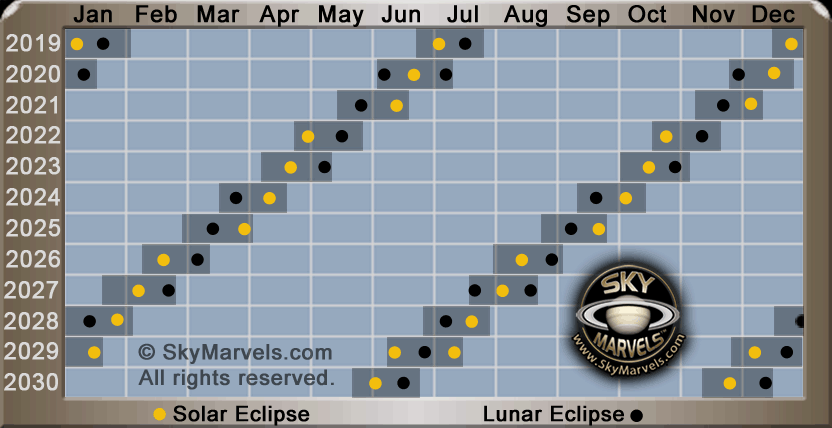
![]() ECLIPSE "SEASONS" 2019 - 2030
ECLIPSE "SEASONS" 2019 - 2030
In the Eclipse Calendar below, hover over any eclipse to reveal its type and date. Click
on it to view its circumstances in a new tab or window, depending on your browser.

Generally occurring twice per year, and never more than three times per year, Eclipse Seasons last for roughly a month and are intervals when conditions are suitable for eclipses to take place. The Eclipse Calendar above makes it easy to see that Eclipse Seasons are cyclical, and that they begin each year slightly less than three weeks earlier than in the previous year. Also, the align- ment and regularity of Eclipse Seasons reveals groupings of eclipses with related geometries.
Remember that eclipses can only occur during New and Full Moons. In fact, during any Eclipse Season, any New Moon will cause a Solar Eclipse, and any Full Moon will experience a Lunar Eclipse!
Note the repeating cycle of diagonal groupings, each containing four eclipses of the same basic type (Solar or Lunar). The first and last eclipses
of any Lunar grouping are always Penumbral or Partial, while the eclipses in the center of such groupings are always Total or Partial. However, in a Solar grouping, Total and Annular eclipses can occur as any of the four, though if first or last in a grouping they are generally only visible near Earth's North and South Poles.
By far, most Eclipse Seasons produce only two eclipses: one solar and one lunar. However, three eclipses in a single season are possible, with a Solar eclipse "bracketed" by two Lunar eclipes or vice versa. This happens in mid-2020, mid-2027 and mid-2029. Most years experience a total of 4 eclipses (2 solar and 2 lunar), with years of 5 or 6 eclipses occurring less frequently. It is possible for 7 eclipses to occur in a single year, though this happens on average only roughly every 33 years. 1982 was the last year this occurred; 2038 will be the next.


Knowing the current relative apparent sizes of the Sun and the Moon can be quite helpful during Eclipse Seasons. How large the Sun and Moon appear can suggest if an upcoming solar eclipse may be Total, Annular or Hybrid. It is in early January when the Sun and Moon "can" appear most unequal in size to us. This is when the Sun is "nearest" to Earth and thus looks its largest in our sky. Near this time, if the Moon is its "farthest" from Earth and thus looks its smallest, it cannot "cover up" as much of the Sun if a solar eclipse occurs. Also, as the Moon is at apogee, it is moving slower than at any other point in its orbit. Therefore the longest Annular Solar Eclipses—at rare times exceeding 12 minutes—occur near a year's beginning or end. In contrast, the Sun is its "farthest" from Earth and smallest in our sky in early July. Near this time, if the Moon is its "closest" to Earth and thus looks its largest, it can hide the Sun to the greatest degree if a solar eclipse occurs. So the longest Total Solar Eclipses—at rare times almost 7½ minutes long—occur near mid-year! Of course, the "maximum possible" size differences between the Moon and Sun are less in July for Total Solar Eclipses (0.559° - 0.524° = 0.035°) than in January for Annular ones (0.542° - 0.490° = 0.052°). This is one reason why the longest Total Solar Eclipses are shorter than the longest Annular ones. Another is that, when it covers the Sun most greatly, the Moon is at or near perigee, so its higher speed shortens the Total Eclipses it produces. Hover over the image directly above for a visual comparison of these circumstances.
Home Intro News Gallery Sky-Gifts Bonuses Tips
Learning Ctr Help Links Credits Legal Contact Us
© 2007-
by Gary M. Winter. All rights reserved.
Interested in political cartoons and humor?
Check out The HIPPLOMATS™.
Eclipses, Eclipse Calendar, Interactive Eclipse Seasons Calendar, Eclipse Seasons, Total Eclipse, Partial Eclipse, Hybrid Eclise, Solar Eclipses, Lunar Eclipses, SkyMarvels, Sky Marvels, SkyMarvels.com, celestia4all, celestiaforall, CELESTIA, astronomy, space, simulations, animations, downloadable astronomy posters, stars, planets, Inner Planets, Outer Planets, Inferior Planets, Superior Planets, moons, asteroids, comets, Oort Cloud, galaxy, galaxies, Milky Way, Andromeda, globular clusters, binaries, quasars, black holes, supermassive black holes, telescope, telescopes, planetarium, software, freestuff, satellites, add-ons, addons, scripts, eclipses, Solar Eclipses, Lunar Eclipses, Solar Eclipse Finder, Lunar Eclipse Finder, mutual eclipses, transits, occultations, Solar System, CELES-TOOLS, celeSTARrium, CELX, CELX programming, Freebies, Bonuses, multiple views, atronomical unit, light year, parsec, meteors, meteor showers, Perseids, Geminids, Leonids, barycenter, time, Time Zones, tides, alignments, conjunctions, oppositions, seasons, apogees, perigees, aphelion, perihelion, Earth, Luna, Mercury, Venus, Mars, Jupiter, Galilean Moons, Io, Europa, Ganymede, Callisto, Saturn, Titan, rings, Uranus, Neptune, Triton, E-MSpectrum, electromagnetic spectrum, astronaut, equinoxes, solstices, precession, rotation, spin, inclination, tilt, Ecliptic, orbits, ellipse, parabola, hyperbola
